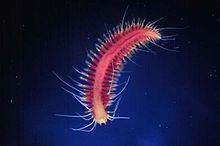Kingdom Animalia Family Hesionidae Scientific name Hesiocaeca methanicola Rank Species | Class Polychaeta Genus Hesiocaeca Phylum Annelida Order Phyllodocida | |
 | ||
Similar Hesionidae, Phyllodocida, Errantia, Eunice, Bathymodiolus childressi | ||
Hesiocaeca methanicola is a species of polychaete worm that inhabits methane clathrate deposits in the ocean floor. The worms colonize the methane ice and appear to survive by gleaning bacteria which in turn metabolize the clathrate.
In 1997, Charles Fisher, professor of biology at Pennsylvania State University, discovered the worm living on mounds of methane ice at a depth of half a mile (~800 m) on the ocean floor in the Gulf of Mexico. Fisher reported that experiments with live specimens showed that mature worms could survive in an anoxic environment for up to 96 hours. The experiments also showed that the larvae were dispersed by currents, and died after 20 days if they did not find a place to feed.
References
Hesiocaeca methanicola Wikipedia(Text) CC BY-SA
